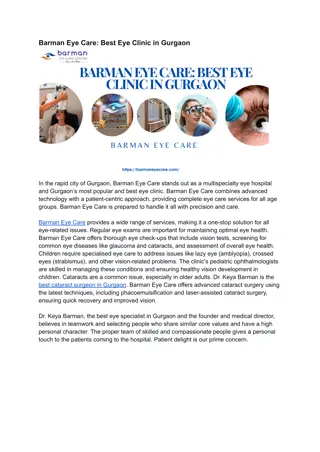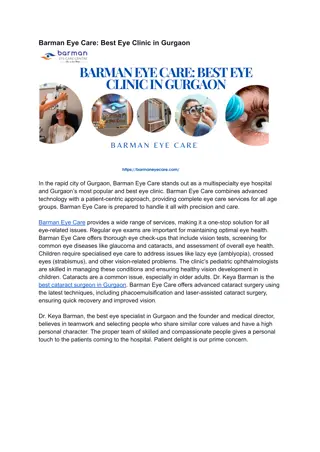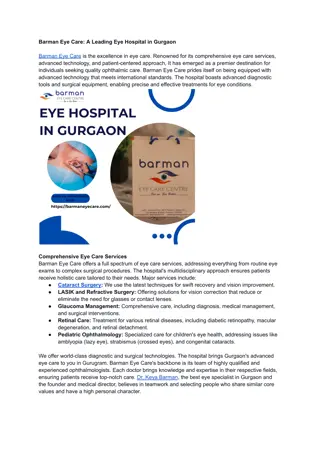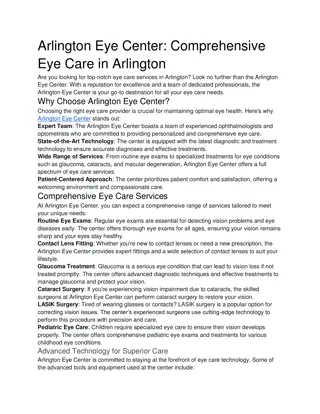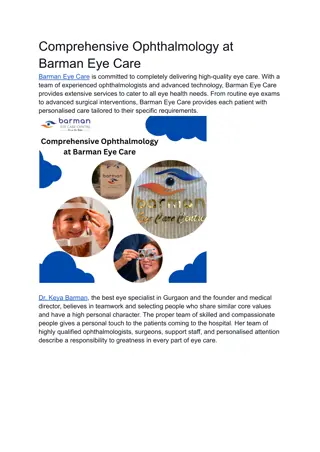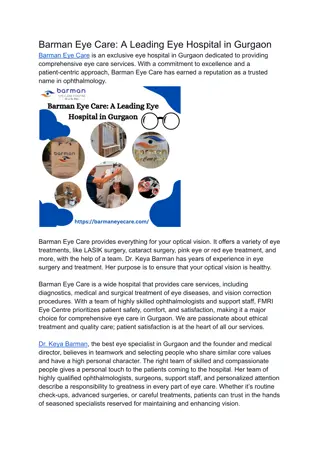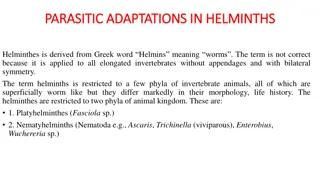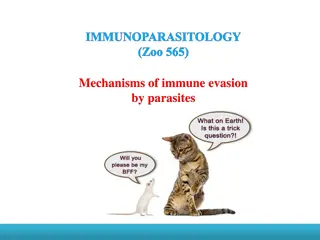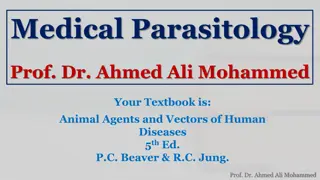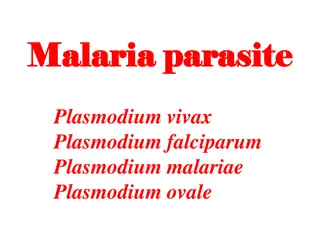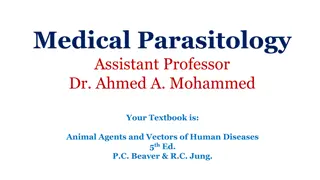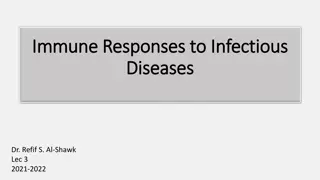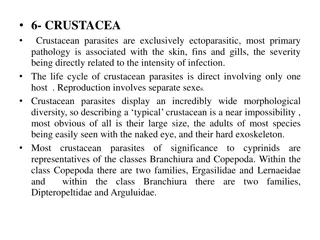Eye Parasites and Their Impact on Humans
Eye parasites, including helminthes and protozoa, can infect humans through various means, causing a range of clinical manifestations. Understanding the pathogenesis, diagnosis, and treatment of these infections is crucial for effective management and prevention. Learn more about common eye parasites such as Dyphyllobothrium mansoni and Taenia solium, their sources, and ways to protect against them.
Download Presentation

Please find below an Image/Link to download the presentation.
The content on the website is provided AS IS for your information and personal use only. It may not be sold, licensed, or shared on other websites without obtaining consent from the author.If you encounter any issues during the download, it is possible that the publisher has removed the file from their server.
You are allowed to download the files provided on this website for personal or commercial use, subject to the condition that they are used lawfully. All files are the property of their respective owners.
The content on the website is provided AS IS for your information and personal use only. It may not be sold, licensed, or shared on other websites without obtaining consent from the author.
E N D
Presentation Transcript
Eye parasites Helminthes: 1- Dyphyllobothrium mansoni 2-Taenia solium 3- Hymenolepis nana 4-Trichnilla spiralis 5- Onchocerca volvulus 6- loa loa Protozoa: 1-Acanthameba 2-Toxoplasma 3-American trypanosomes Arthropoda: Auricular myasis
1- Dyphyllobothrium mansoni by Sparganosis It is the infection of human tissues by the plerocercoid larva (sparganum) of other pseudophyllidian tapeworms as Diphyllobothrium mansoni (Spirometra erinacei) and D. proliferum. The definitive host of these cestodes is dogs and cats, while their natural intermediate host is tadpoles and reptiles. The eggs are discharged in the faeces of the host, these embryonate when they are in fresh water. The first intermediate host is Cyclops, where the procercoid develops. The second intermediate host (frogs or tadpoles, birds, reptiles or snakes) gets the infection by swallowing infected Cyclops. Other mammals can be paratenic hosts.
Man can get the infection as follows: Swallowing Cyclops containing procercoid with drinking water. Eating raw or undercooked flesh of infected 2nd. intermediate host as in Far East. Folk medicine in some areas uses the flesh of these animals as fomites or poultice for wounds, eyes or inflamed parts of the body. When the flesh is infected, the sparganum migrates to the hot human tissues.
Pathogenesis and clinical manifestations: Presence of sparganum in human tissue elicits an intense inflammatory reaction in the infected area. Procercoids after penetrating intestine may pass with circulation to be lodged in the lungs or other organs. Pulmonary infection may cause pulmonary hemorrhage, while brain infection may be fatal. Ocular and cutaneous infections usually are due to local application of infected flesh. In the eye there is palpebral edema and conjunctivitis, while in the skin there is inflammation, induration and edema. Death of the larva causes intense reaction.
Diagnosis and treatment: It is established by finding the larva, and usually surgical removal is the only treatment, with additional anti- inflammatory drugs. Prevention is by filtering or boiling drinking water in endemic areas, thorough cooking of flesh of suspected intermediate hosts and avoiding the use of this flesh as foments.
Taenia solium (Cysticercosis): Man can be infected with T. solium eggs either by external autoinfection (hand to mouth), or from soiled vegetables), or internal autoinfection when gravid segments pass back to the stomach with antiperistalsis during vomiting or anesthesia. Gastric juice breaks the embryophore and the onchosphere completely becomes free in the duodenum. The onchosphere penetrates intestinal wall and passes with circulation to the liver, lungs and then systemic circulation to the brain, kidneys, eye and muscles.
The cyst elicits an immunological inflammatory reaction in the surrounding tissue. This begins by aggregation of lymphocytes, monocytes, then aggregation of fibroblasts, transformation into fibrocytes and the cysticercus becomes surrounded by a fibrous capsule. Eventually calcification occurs in the cysticercus.The inflammatory reaction can pass unnoticed in organs like liver or gives mild symptoms. In case of muscles it causes myositis and limitation of movement. Cerebral cysticercosis causes neurological symptoms.
Diagnosis: The adult worm: as in T.saginata. Cysticercosis: Biopsy whenever possible. X-ray (may show calcification present in old cases). Ultrasonography, C.T., MRI can show the lesions in liver or brain. Serological tests. Immunological tests, these are available in endemic areas even to pig-raising farms.
Treatment: The adult: as in T.saginata, but anti-emetic drugs should precede treatment to prevent vomiting and reverse peristalsis which gives the eggs returning to the stomach a chance to hatch and produce Cysticercosis. Cysticercosis: Surgical treatment (if available) in association with anti-inflammatory drugs and steroids to prevent immune reaction. Prevention and control: Sanitary sewage disposal. Avoiding plant fertilization with human excreta. Proper inspection of restaurants and food handlers, as well as slaughterhouses. Cooking meat for enough time to kill cysticerci, or freezing at - 10 C for 5-10 days.
Hymenolepis nana: Disease: Hymenolepiasis nana. Host: Definitive: Humans especially children, mice and rats. Intermediate hosts: grain beetles and rat fleas. Distribution: All over the world, but most prevalent in temperate areas with poor sanitary conditions
Life cycle: Adults live in the small intestine and produce mature eggs, which are already infective. The intermediate host is optional both in case of humans and rodents. When the final host swallows the egg by autoinfection, polluted hands, food or water, the onchosphere hatches in the small intestine. It buries itself in the lymph channels of the villi to become a cysticercoid. After about one week it returns to the lumen and matures into an adult worm in about 2 weeks. So man can act as an intermediate and as a definitive host.
Larvae of fleas and beetles can also serve as intermediate host. They eat up the eggs during feeding on organic excrements of mice and rats. The eggs hatch in their intestine and the onchosphere penetrates to the hemocele and stays there till it transforms to cysticercoid while the larva maturates into an adult flea, which must be ingested to complete the life cycle. Internal autoinfection could also occur, the eggs hatch in the intestine before passing out, this occurs most frequently in immunocompromised persons.
Pathogenesis and clinical picture: They are rare, and usually occur in massive infections, where enteritis, abdominal discomfort, loss of appetite, colic and diarrhea with passage of mucus may occur. Allergic manifestations due to tissue phases as flectins or flectinular conjunctivitis (around the cornea) was also reported. Neurotoxic products of the worms also tend to cause dizziness and convulsions especially in children.
Diagnosis: By recognition of the characteristic eggs in the fecal sample. Treatment: Praziquantel acts very rapidly against Hymenolepis nana, both for luminal and tissue phases. Yomesan is effective for luminal phases only, so must be given at weekly intervals for two or three times. Prevention and control: Proper personal hygiene. Treatment of infected persons. Rodent control.
Trichnella spiralis: Disease: Trichiniasis, trichinosis or trichinelliasis. Distribution: All continents especially the Northern Hemisphere and Australia. Host: Rat, pig, foxes, bears, many other animals, uncommonly horses and human. Mode of infection: Eating raw pork meat containing viable encysted larva in muscle Diagnosed by serology and muscle biopsy
Life cycle: Adults live in the mucosa of the small intestine of the host. The males do not penetrate mucosa like females. Soon after fertilization males die and females become embedded in mucosa and lay larvae. Females live for about 2-4 months and lay between hundreds to thousands of larvae throughout their life. Larvae find their way to the circulation, pass the liver, the heart and the lungs to reach the arterial system, which distributes them throughout the body. The most preferable muscular sites for larval invasion are: the muscles of the eye, tongue, mastication muscles, then the diaphragm, intercostals and finally the heavy muscles of the arm and leg.
On reaching the skeletal muscles, they penetrate the muscle fibers, which are turned to nursing cells. The parasite-nurse cell complex is then encapsulated by the neighboring fibroblasts. By 1- 2 month the larvae are 1mm long and they are ready for infecting their next host. By this time one can say that Trichinella spiralis uses the host as final and intermediate host at the same time. Larvae can live for months to years in that condition until they eventually become calcified due to tissue reaction, but never mature to adult in the same host. When living larvae of an animal host are swallowed by man, they reach the small intestine and are released from their nursing cell to enter the mucosa. Four molts, maturation and fertilization occur within 30-32 hours after infection. N.B.: Rat and mouse faeces contain larvae that can infect pigs and humans.
Pathogenesis: Stage of intestinal mucosa penetration (Enteric phase): Stage of wandering larvae: May be accompanied with pneumonia, pleurisy, encephalitis, meningitis, nephritis, deafness, peritonitis and subconjunctival or sublingual hemorrhage. Localized areas of necrosis and leucocytic infiltration of the cardiac muscles may lead to death. Stage of muscular penetration ( by about the tenth day): Symptoms include eyelids swelling, facial oedema, intense muscular pain, difficulty in breathing and swallowing, swelling of the masseter muscle, lowered blood pressure and nervous disorders. Extreme eosinophilia is common. After about the second month symptoms begin to decrease, but symptoms of congestive heart failure may appear. Stage of Encapsulation (Encystment phase): The clinical disease is self-limited and usually lasts 2 to 3 weeks in light and 2 to 3 months in heavy infections.
Diagnosis: Adults or larvae may be accidentally seen in the patient s faeces in early infection. Muscle biopsy: Examination is done by compressing the muscle between two slides (trichinoscopy) or digesting the fibers in artificial gastric enzymes for several hours then microscopic examination under low-power. Immunodiagnosis: Intradermal test (Bachman test): Serological tests: ELISA, LA (Latex agglutination), CEP (counter- current electrophoresis), CFT (Complement fixation test), FAT (fluorescent antibody test) IHA and PCR. Blood examination shows eosinophilia. X-ray may reveal calcified larvae.
Treatment: No satisfactory treatment is yet known for adults or larvae, but care is only directed to relieve the symptoms. This includes analgesics and corticosteroides. However benzimidazole i.e. mebendazole (200mg/day for5days) )gave variable results in human patients. Control: Thorough cooking or freezing (maximum at -15 C for at least 20 days or 23 C for 10 days) of pork and horsemeat to destroy larvae. Inspection of meat in the slaughter houses using trichinoscope. Rat control.
Onchocerca volvulus Disease: blindness. Distribution: Tropical Africa, Asia, and Central America, near fast running water and water falls. Hosts: Final host: Humans. Intermediate host: Simulium (mainly S. dumnosum) (The black fly). Life cycle: Nearly similar to Wuchereria bancrofti. Onchocercosis, Onchocerciasis or river
Clinical picture: Onchocercoma. Severe depigmentation (leopard skin). Ocular lesions leading to blindness (riverine blindness). There may be some degree of fibrosing obstructive lymphadenitis associated with elephantiasis and hanging groins (large redundant skin folds in the lower abdomen and groin). itching, skin rash, lesions and
Diagnosis: Skin snips . Aspiration of nodules can show microfilariae, surgical removal and sectioning can reveal the adults.
Loa loa (The African eye worm) Disease: Loasis Distribution: Tropical Africa. Host: Final host: Humans Intermediate host: Chrysops or mango fly. Life cycle: Nearly similar to Wuchereria bancrofti.
Pathogenesis: Adults lives subcutaneously migrating freely from place to place and may appear under the conjunctiva (eye worm). Presence of the worm may lead to acute inflammation from mechanical injuries, effect of metabolites and the host immune reactions. As a result from these acute inflammations, transient cutaneous swellings (Calabar or fugitive swellings) appear. They are about the hen s egg, slightly painful, itchy, non- pitting and they appear and disappear within few days. There may be fever, urticaria and eosinophilia.
Diagnosis: In endemic areas, provisional diagnosis is possible from the symptoms. Diurnal, thick blood film showing microfilariae is a sure way for diagnosis. Treatment: DEC + General and surgical measures.
Acanthamoeba It is free-living soil amoeba, present as trophozoite and cyst stages in moist soil, fresh and brackish water, air condition filter and in dialysis units. The trophozoites are of the same measures as Naegleria, have spiky acnthopoda, move slowly, with large vesicular nucleus and large karyosome. The cysts are uninucleate with thick wall.
Pathogenecity: Acanthameba cause chronic infection of the skin and CNS in immunocompromised patients, and corneal ulceration and keratitis in immunocompetent persons who use contact lenses. Its effect is by direct invasion and feeding on lysed tissues as in Naegleria.
Clinical picture: 1-Amebic keratitis:- Occurs in immunocompetent persons through contamination of water or contact lenses solution. Keratitis leads to visual affection with severe pain and the lesion is irreversible. Corneal abrasions may enhance the infection. Sometimes the infection results in corneal perforation. 2- Granulomatous amebic encephalitis (GAE):-The infection may be blood spread from lungs or skin ulcers. It is a chronic disease with signs of a focal lesion in the brain. Diagnosis: Corneal smear in case of amebic keratitis. CSF examination in case of brain affection may be helpful in addition to CT examination or MRI. Culture of corneal scrapings or CSF. on agar as in Naegleria.
Toxoplasma: Toxoplasma gondii is an obligate intracellular coccidian parasite Hosts: The parasite thus has many carnivorous definitive hosts, especially cats and other felines. Also many intermediate hosts like ruminants, pigs, rodents, primates and man as well as birds. Life cycle: Both enteroepithelial (sexual) and extraintestinal stages can occur in the definitive host, the cat. Some infective sages enter the epithelial cells. Others penetrate to develop in the lamina propria, then to the mesenteric lymph nodes and white blood cells to be disseminated to distant organs. Inside the intestinal cell the parasite begins as a trophozoite which grows to schizont and produces about 40 merozoites. These initiate several asexual cycles in the same way within 3-15 days, then begin to form gametocytes.
The shed oocysts are immature, and need oxygen for sporulation, which occurs within 5-15 days. Infection of the intermediate hosts and man occurs by: (1) Ingestion of sporulated oocysts with polluted food through indirect ways as cat often buries its stools in the ground. Contamination with sporulated oocysts thus occurs either air borne, water borne or through roaches, flies, earthworms, and beetles carrying the parasites on the body hairs to raw vegetables and grass. (2) Ingestion of tissue cysts from infected animals either by carnivores, or consumption of undercooked meat by human hosts. (3) Soiling of hands during household duties like emptying the cat s litter box or preparing meat for cooking. Extraintestinal stages only can occur in other mentioned hosts in the same way as in cats.
Pathogenesis and effect on the eye: Though Toxoplasma is a cosmopolitan disease, and Toxoplasma antibodies are frequently detectable in many persons, clinical cases are uncommon. This depends on the virulence of the parasite strain, the host s species susceptibility, the age of the host and the degree of acquired immunity. Chronic infection results when immunity becomes enough to suppress tachyzoites proliferation. This coincides with cyst formation. The cysts can remain intact and the condition becomes asymptomatic for years. Occasionally cyst wall breaks down releasing bradyzoites. Some of them succeed in reinvasion of host cells, but the majority is killed by the immune system of the host. Killing of bradyzoites elicits intense inflammatory reaction.
In the brain it causes formation of glial nodules, which may cause encephalitic symptoms if they are numerous. This may cause also retinal blind spots or small infarcts, which may coalesce in the macula causing blindness. The same pathology in other tissues may cause myocarditis, hepatosplenomegaly, and pneumonia. In immunosuppressed persons, the symptoms are more sever Congenital toxoplasmosis: There is either abortion or fetal death according to gestational age, premature births are also common. Cerebral manifestations are abnormal spinal fluid, convulsions, hydrocephalus, intracerebral calcifications, anencephaly and mental retardation. Retino-choroiditis, retinitis and blindness are the ocular manifestations. Ocular manifestations may appear later in children. The newborn may have rash, fever, hepatosplenomegaly and sometimes myocarditis.
Diagnosis: Demonstration of the parasite: this occurs by lymph node, bone marrow or liver biopsy, which are examined for tachyzoites or tissue cysts. Serological tests are by far the best way for diagnosis. They do not need invasive procedure like biopsy, and are more rapid. Toxoplasmin test: Sabine-Feldman test (Dye test): Complement fixation (CFT), indirect hemagglutination (IHAT), and indirect fluorescent antibody tests (IFAT) are used also for detection of antibodies in tested sera. ELISA tests are useful now for detection of Toxoplasma immuno-globulins. Toxoplasma IgG indicates presence of chronic infection, while Toxoplasma IgM indicates acute infection. Treatment Combined treatment with pyrimethamine and sulphonamides or cotrimoxazole may lead to clinical cure, though the parasites may not be eliminated. Spiromycin and clindamycin have also been used.
Trypanosoma cruzi (American trypanosomes) T. cruzi is distributed throughout most of South and Central America. It is transmitted by Triatoma megista. The reservoir hosts are small mammals in the vicinity as dogs, cats, opossums, armadillos and wood rats. Life cycle of T. cruzi: 1.Trypomastigote form enters midgut of reduviid bug and transforms into Epimastigote form which migrates to hindgut, multiplies and becomes 2. Metacyclic trypomastigote which is shed in faeces and infects vertebrates. 4. Trypomastigote in blood enters reticuloendothelial and other tissue cells 5. In which it passes through epimastigote and promastigote stages to become amastigotes which replicate and again through promastigote and epimastigote stages become 6. Trypomastigotes released into bloodstream. These are the infective forms for the vector bug.
Clinical manifestations: The disease has two clinical stages; acute and chronic. The acute stage: This begins immediately after infection by the local skin reaction named chagoma. It is a swollen red nodule at the site of bite accompanied by swelling of the regional lymph nodes. If trypanosomes enter the body through conjunctiva of the eye, they cause swelling of the eye lids and regional preauricular lymph node. This is known as Romana s sign. It is common in children. Parasites at this time can be found in tears and conjunctival swabs. Symptoms of the acute phase are fever, anemia, loss of weight and strength, nervous disorders, chills, muscle and bone pains, and varying degrees of heart failure. Death may occur within 3-4 weeks after infection.
The chronic stage: Megaesophagus, megacolon, dysphagia Congenital Chaga s disease: Diagnosis: 1. Demonstration of the trypanosomes in blood in stained peripheral blood smears 2. Animal inoculation. 3. Xenodiagnosis, 4.culture of blood or biopsy material on NNN media if and the culture is examined for 4 weeks for epimastigotes. 4. Immunodiagnostic tests as complement fixation, indirect hemagglutination (IHAT) and ELISA are useful also for diagnosis. 5. An intradermal
Treatment: Nifurtimox
Myasis Definition: It is the infestation of human and animal tissues by dipterous fly larvae. Classification: According to (the habits) of flies: Specific myiasis: in which the fly larvae are obligatory parasites of living tissue, and cannot live outside it. It is caused by some members of Family Calliphoridae (Cochliomyia, Cordylobia), Gastrophilus sp., Hypoderma bovis, Dermatobia hominis, and Oestrus ovis. Semispecific (facultative) myiasis: larvae of flies in this case can complete development in decaying organic matter, carcasses, but can parasitize human and animal hosts. is produced by Families Sarcophagidae and Calliphoridae e.g. Sarcophaga,Wohlfahrtia, Calliphora, Lucilia and Chrysomyia. Accidental myiasis: this is accidental passage of fly larvae with stools or vomitus. These are Musca, Fannia, Lucilia Chrysomyia and Erysitalis, putting eggs around inflamed or soiled body orifices, and on food or fruits.
Ocular myiasis (ophthalmomyiasis), this is either by the larvae feeding on the discharge of the inflamed eye (semispecific) e.g. calliphoridae, Musca - or by selective penetration of intact palpebral skin and conjunctiva, e.g. Oestrus ovis.
Formative exam: 1-All the following parasites affect the eye except: A-Trichnilla spiralis B-Taenia solium C-Ascaris lumbricoides D-Acanthameba E- Diphyllobothrium mansoni 2- Hymenolepis nana can affect the eye by causing: A- tissue cysts B- chaggoma C- myasis D- cysticercosis E- flectin formation
3- blindness can occur by infection with: A-Anchylostoma duodenalis B- enterobius vermicularis C- Schestosoma hematobu-ium D- Diphyllobothrium latum E- Onchocerca volvulus 4- Sparganosis infection can occur by : A- procercoid larva B- plerocercoid larva C- egg D- Both a and b E- Non of the above
5- In Toxoplasma infection: A- cat is intermediate host B- cat is definitive host C- humans are definitive hosts D- birds are definitive hosts E- non of the above



